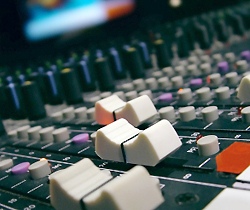
Ever have problems with stage volume that’s just too loud? Combating sound issues from performers who can’t hear themselves play – much less think – can be tough.
How many times have you pulled down the master faders to (-) infinity at front of house, and the sound coming off the stage was still so loud you knew you were going to get a visit from the head deacon or usher before the first chorus?
Or how about the worship leader who leads from the piano? His complaint is he can’t hear himself, but he has the high freq section of the monitor aimed at the piano, and the woofer is the only thing aimed at his ears.
The monitor gets turned up and blasts the soundboard of the piano, which is picked up by the piano mic, which gives you a nice 55-gallon drum sound (true story). The piano has a muddy sound in the monitor, no definition, gets turned up (because they can’t hear) and drowns out the worship leader’s voice.
Now the vocal needs to be turned up, resulting in a mix that no one is happy with. Not to mention the sound tech must mix over this roar.
The sound mixer has a few options:
1. Raise the overall house volume level to get on top of the stage noise
2. Don’t put any piano in the house mix because there is enough piano volume coming off the stage
3. Touch the knob and smile
These are not very good options…
The purpose of this article is not to be condescending, or to start a conflict between stage performers and the sound/media team, but to educate all involved about a few laws of physics that we all have to obey. Many sound problems that are a constant weekly battle can be fixed without spending a ton of money.
Examine your monitor system. The first thing we need to do is take a comprehensive look at your monitor system. Are you mixing monitors from the front of house (FOH) mix position, a dedicated monitor console, or onstage personal monitor mixers?
If you are mixing from front of house, make sure your aux sends are “pre-fader.” This means all adjustments happen before the fader and any fader adjustments will not affect your aux mix.
A “post-fader” aux means that any adjustment that you make, EQ or fader, will affect the aux level. This will give you an inconsistent monitor mix and an unhappy musician because the mix is always changing.
Make sure that your floor monitors (wedges) are pointing at the musician’s ears. Sometimes wedges are pointing at knees or the ceiling. Be aware of the coverage pattern of the horn. Do you have too many people sharing a monitor?




















